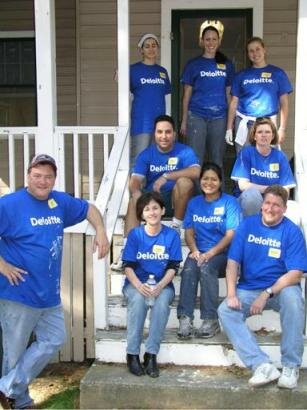 A company that volunteers is a happier and better company, but that is only a small part of the picture. The support and encouragement that an employer gives to its employee’s volunteer activity can make a world of difference to their outcome! From something as simple as a kind word to an elaborate partnership with a local nonprofit organization, there are many ways employers can encourage volunteering among their staff. A variety of approaches can be utilized to reinforce or complement one another and suit the needs of the company. Read on to find an approach that is right for your organization.
A company that volunteers is a happier and better company, but that is only a small part of the picture. The support and encouragement that an employer gives to its employee’s volunteer activity can make a world of difference to their outcome! From something as simple as a kind word to an elaborate partnership with a local nonprofit organization, there are many ways employers can encourage volunteering among their staff. A variety of approaches can be utilized to reinforce or complement one another and suit the needs of the company. Read on to find an approach that is right for your organization.
Acknowledgement
Acknowledging the volunteer work of employees may seem like a small thing, but projects and people alike thrive on acknowledgement. How can the employer acknowledge that employees are involved as volunteers and try to accommodate this reality whenever possible?
- Counting relevant volunteer work as experience when considering candidate for a promotion
- Allowing leaves of absence without pay for volunteer work
- Allowing employees to adjust their work schedules to make it possible to carry out their volunteer work activities
Promotion
Recognition of employees who are involved with voluntary organizations and highlighting their achievements creates an atmosphere in which other employees become eager to be involved and be recognized themselves! How can an employer promote the service employees are doing?
- Sending a letter or memo to all employees in which the CEO expresses his or her views on the value of volunteer participation
- Sending a thank you note to employees during National Volunteer Week
- Publishing activities or a regular column in the company newsletters profiling the volunteer work of employees
Encouragement
Perhaps the employer has already acknowledged and promoted staff volunteer work. Take the next step, with policies that encourage employees to volunteer!
- Encouraging volunteer work as a legitimate way to gain skills and experience for professional development
- Offering pre-retirement seminars promoting volunteer work
- Featuring appeals in internal newsletters from employees on behalf of organizations they support
- Inviting speakers from volunteer organizations to address employees
 Endorsement
Endorsement
Several entities have a vested interest in service work done by employees. Get local nonprofits involved by working actively with volunteer groups to encourage employees to do volunteer work. How can an employer do this effectively?
- Liaisons with a local volunteer center regularly to make employees aware of volunteer jobs available in the community
- Developing a skill bank to record the skills and experience of employees who are interested in volunteer positions
- Offering to help in kind or free services to the organizations for which employees volunteer without requiring the organization to identify or publicize the source
Sponsorship
Perhaps your company is saturated in the spirit of volunteerism already! It may be time to consider sponsorship, volunteer work done under the auspices of the company. How can an employer institute this corporate driven element of service?
- Appeals to the employees to volunteer for a specific organization
- Nomination of employees to serve on the board of a specific volunteer organization
- Employer sanctioned volunteer time and company projects that take place in regular working hours
How does your organization support staff service? Let us know in the comments below.

 Experts and layman alike agree that employee volunteering is a good thing. A strong employee volunteer program can make a company develop employee skills, develop customer loyalty, improve relationships with the community, and spur innovation and creativity. In addition, time-crunched employees are increasingly looking to their jobs to provide opportunities for the good deeds that they don’t have the hours for outside of work. Read on to discover clear principles of excellence and best practices to create a successful workplace volunteering program.
Experts and layman alike agree that employee volunteering is a good thing. A strong employee volunteer program can make a company develop employee skills, develop customer loyalty, improve relationships with the community, and spur innovation and creativity. In addition, time-crunched employees are increasingly looking to their jobs to provide opportunities for the good deeds that they don’t have the hours for outside of work. Read on to discover clear principles of excellence and best practices to create a successful workplace volunteering program.
 Time-crunched employees are increasingly looking to their jobs to provide opportunities for the good deeds that they don’t have the hours for outside of work, and companies are responding. Corporate social responsibility programs are no longer an afterthought in corporate planning, but garner big payoffs.
Time-crunched employees are increasingly looking to their jobs to provide opportunities for the good deeds that they don’t have the hours for outside of work, and companies are responding. Corporate social responsibility programs are no longer an afterthought in corporate planning, but garner big payoffs.
 We were lucky enough to have a relationship with Medshare’s CEO Meredith Rentz, who used to be a Points of Light’s COO. She helped pave the way to bring the Atlanta office’s staff to Medshare to spend the morning volunteering.
We were lucky enough to have a relationship with Medshare’s CEO Meredith Rentz, who used to be a Points of Light’s COO. She helped pave the way to bring the Atlanta office’s staff to Medshare to spend the morning volunteering. Be sure to choose a task that doesn’t require any special skills, or plan time to train the employees before the event. The staff at Medshare did a great job of explaining their mission, the work that volunteers would be doing, and how to do the work that Points of Light staff were being asked to do.
Be sure to choose a task that doesn’t require any special skills, or plan time to train the employees before the event. The staff at Medshare did a great job of explaining their mission, the work that volunteers would be doing, and how to do the work that Points of Light staff were being asked to do. Work with organizations that have projects where employees can see and experience the impact of their work. As we packed medical supplies, we got to see the piles of boxes on pallets grow. The staff at Medshare also took the time to tell us short stories throughout the day about the impact our work would have on the recipients of the supplies we were packing.
Work with organizations that have projects where employees can see and experience the impact of their work. As we packed medical supplies, we got to see the piles of boxes on pallets grow. The staff at Medshare also took the time to tell us short stories throughout the day about the impact our work would have on the recipients of the supplies we were packing. We had a great time volunteering with Medshare, learned some great lessons about employee volunteer projects and medicine in the developing world, and had a lot of fun while we were doing it!
We had a great time volunteering with Medshare, learned some great lessons about employee volunteer projects and medicine in the developing world, and had a lot of fun while we were doing it! Today’s post comes from Chris Jarvis, Co-Founder and Senior Consultant for
Today’s post comes from Chris Jarvis, Co-Founder and Senior Consultant for I want to be very clear – I am a fan of
I want to be very clear – I am a fan of  A few days ago, Deloitte released their 2011 Volunteer IMPACT Survey which looks at the connection between volunteering in the workplace and employee engagement – focusing on millennials in the workplace. The survey found that millennials who frequently participate in workplace volunteer activities are more likely to be proud, loyal, and satisfied employees as compared to those who rarely or never volunteered.
A few days ago, Deloitte released their 2011 Volunteer IMPACT Survey which looks at the connection between volunteering in the workplace and employee engagement – focusing on millennials in the workplace. The survey found that millennials who frequently participate in workplace volunteer activities are more likely to be proud, loyal, and satisfied employees as compared to those who rarely or never volunteered.



 1. Family Volunteering increases employee morale and builds a positive attitude in the workplace.
1. Family Volunteering increases employee morale and builds a positive attitude in the workplace.

